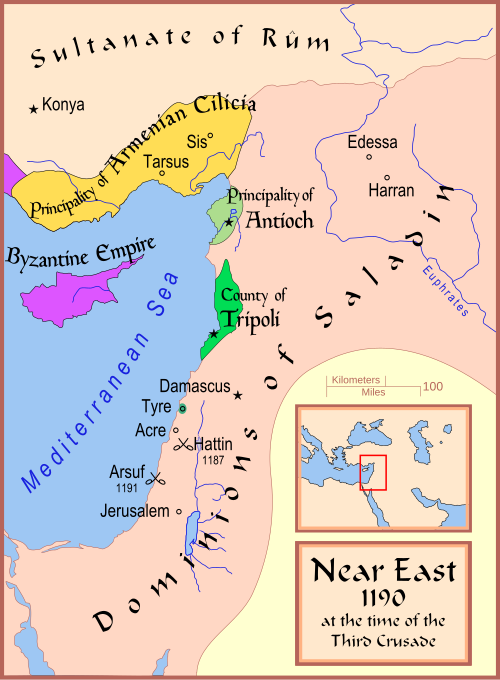Year 1190: A Year of Turmoil and Change
Year 1190 (MCXC) was a common year starting on Monday of the Julian calendar, marked by significant events primarily in the Byzantine Empire and during the Third Crusade.
Events by Place
Byzantine Empire
In the spring, a formidable German expeditionary force consisting of approximately 15,000 men, led by Emperor Frederick I (Barbarossa), advanced towards Constantinople en route to the Holy Land. Emperor Isaac II (Angelos), harboring suspicions of Frederick’s intentions to conquer Constantinople, mounted an offensive against the Crusaders. Despite his efforts, the German forces captured Adrianople and subsequently negotiated a peace treaty granting them supplies and free passage to Palestine.
Meanwhile, Isaac II initiated a campaign against the Bulgarians, who were asserting their independence. After traversing the Balkan Mountains, Isaac laid siege to Tarnovo, the burgeoning Bulgarian capital. In a twist of fate, the Byzantines were ambushed in the Battle of Tryavna and suffered a rout, with Isaac barely escaping thanks to his Varangian Guard. The Bulgarians seized the imperial treasure, including Isaac’s golden helmet, crown, and the sacred Imperial Cross.
Third Crusade
In March, Frederick I departed from Adrianople toward Gallipoli at the Dardanelles, preparing to embark on a crossing into Asia Minor with the assistance of Byzantine transports. Upon entering the territory of the Seljuk Sultanate of Rum, ruled by Sultan Kilij Arslan II, Frederick’s forces faced harassment from Turkish hit-and-run attacks despite a promise of safe passage.
By May 7, Frederick’s Crusaders triumphed over a Turkish army of 10,000 men at the Battle of Philomelion, showcasing their resilience. However, conditions for the Crusaders worsened when, on May 18, they achieved a decisive victory at Iconium, defeating a Seljuk army of 40,000 men, yet Frederick refrained from pressing the advantage due to dwindling resources.
Tragedy struck on June 10 when Frederick I drowned in the Göksu River, leading to a demoralized German contingent. His son, Frederick VI, took command and continued the campaign with a significantly reduced force, eventually reaching Antioch.
As the year progressed, various significant military engagements were recorded, including failed assaults on the city of Acre and the culmination of alliances such as the marriage of Isabella I to Conrad of Montferrat, solidifying his position as de facto king of Jerusalem by November 24.
Europe
On July 4, King Richard I (the Lion Heart) and Philip II (Augustus) convened at Vézelay, where they agreed to evenly distribute the spoils of their Crusade. Richard, leading a large contingent of 17,000 men, set sail for Sicily, demanding the release of his sister Joan of England, who was held hostage by the usurper Tancred of Lecce.
Richard’s military campaigns throughout the year, including the capture of Messina and subsequent negotiations with Tancred, highlighted the intricate political landscape of the time.
England
In England, the Cross of St. George was officially adopted in London, serving as a symbol for the fleet and providing protection for traders in the Mediterranean.
March marked a dark chapter with a massacre of the Jewish community in York, where between 150 to 500 individuals perished in a tragic event at Clifford’s Tower.
Cultural Developments
Art and Science
This year also saw the publication of On the Harmony of Religions and Philosophy (ar. Kitab fasl al-maqal) by Averroes and the Speculum Virginum, a notable German manuscript.
Education
Emo of Friesland, a Frisian scholar, commenced studies at what would eventually become the University of Oxford.
Religion
The establishment of Cartmel Priory by William Marshal and the founding of the Studenica Monastery in Serbia signified important religious developments of the era.
Notable Births and Deaths
Births
- July 24 – Yelü Chucai, Chinese statesman (d. 1244)
- December 30 – Ibn Abi’l-Hadid, Arab scholar (d. 1258)
- Various other notable figures from different regions such as Gerhard II of Lippe and Heinrich I von Müllenark.
Deaths
- February 18 – Otto II (the Rich), margrave of Meissen (b. 1125)
- June 10 – Frederick I (Barbarossa), Holy Roman Emperor (b. 1122)
- July 25 – Sibylla, queen of Jerusalem (b. 1160)
- Multiple other significant figures from the realms of nobility and religious leadership.
The year 1190 was a defining moment filled with conflict, alliances, and cultural advancements, shaping the course of history in Europe and the Near East.

